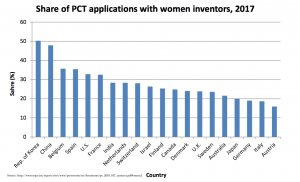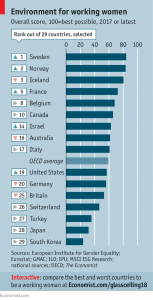Faced with the problem of a declining birthrate, an aging population and a declining labor force, Japan has been expecting women’s more active participation in society. Recently, certain data suggested that women’s participation is also important for promoting innovation.
On July 16 2018, it was 伝えられました。 that Development Bank of Japan concluded that companies’ research and development would create higher economic value patents, if it involves both male and female inventors. The economic value in this analysis is calculated based on the value of patent assets calculated from the company’s market capitalization etc. and the number of papers that cite the patent. The result of analysis reportedly shows that the economic value of a patent which was jointly invented by male and female inventors is 1.5 times the value of a patent which was invented by a single male inventor, and also higher than the value of a patent which was jointly invented by multiple male inventors.
Another report which was published by a government-affiliated research institute RIETI (Research Institute of Economy, Trade and Industry) in February 2016 also shows that companies which have more and a higher percentage of female researchers file more patent applications from more variety of fields.
 Now it has been discovered that women’s participation brings good results on patents both quantitatively and qualitatively. Women’s more active participation might be a key to improve Japan competitiveness. Unfortunately, however, the progress of women’s participation is slow in Japan. Actually, Japan is ranked lower in the share of PCT application with women inventors that was published by WIPO in April 2018, while Korea and China are top 2.
Now it has been discovered that women’s participation brings good results on patents both quantitatively and qualitatively. Women’s more active participation might be a key to improve Japan competitiveness. Unfortunately, however, the progress of women’s participation is slow in Japan. Actually, Japan is ranked lower in the share of PCT application with women inventors that was published by WIPO in April 2018, while Korea and China are top 2.
 It might take a little more time to change the situation. Because it is required to change not only the rules or employment system to make women easier to work, but also social values especially in postfigurative Japan. Indeed, Japan is ranked 28th in the Economist Glass-ceiling index, and commented as “Japan continues to hold the worst place to be a working woman.”.
It might take a little more time to change the situation. Because it is required to change not only the rules or employment system to make women easier to work, but also social values especially in postfigurative Japan. Indeed, Japan is ranked 28th in the Economist Glass-ceiling index, and commented as “Japan continues to hold the worst place to be a working woman.”.
Which companies can succeed in taking full advantage of women’s ability and raise competitiveness?





